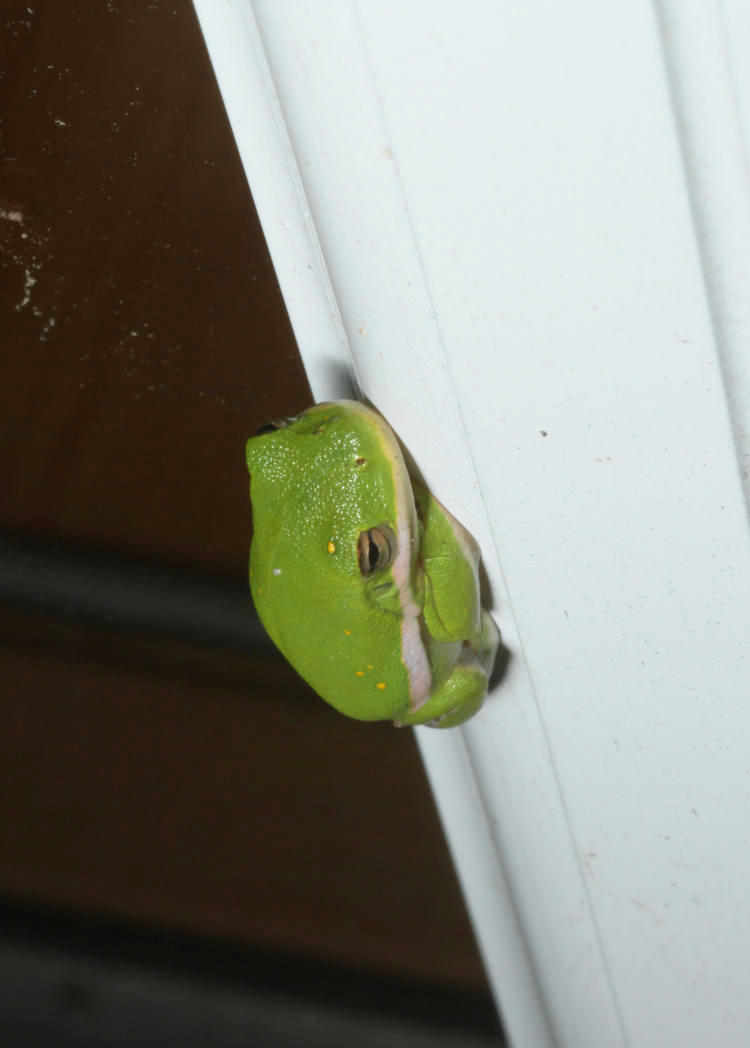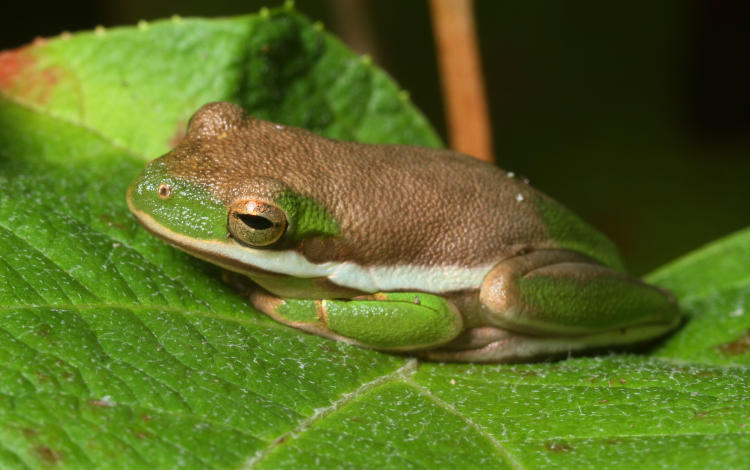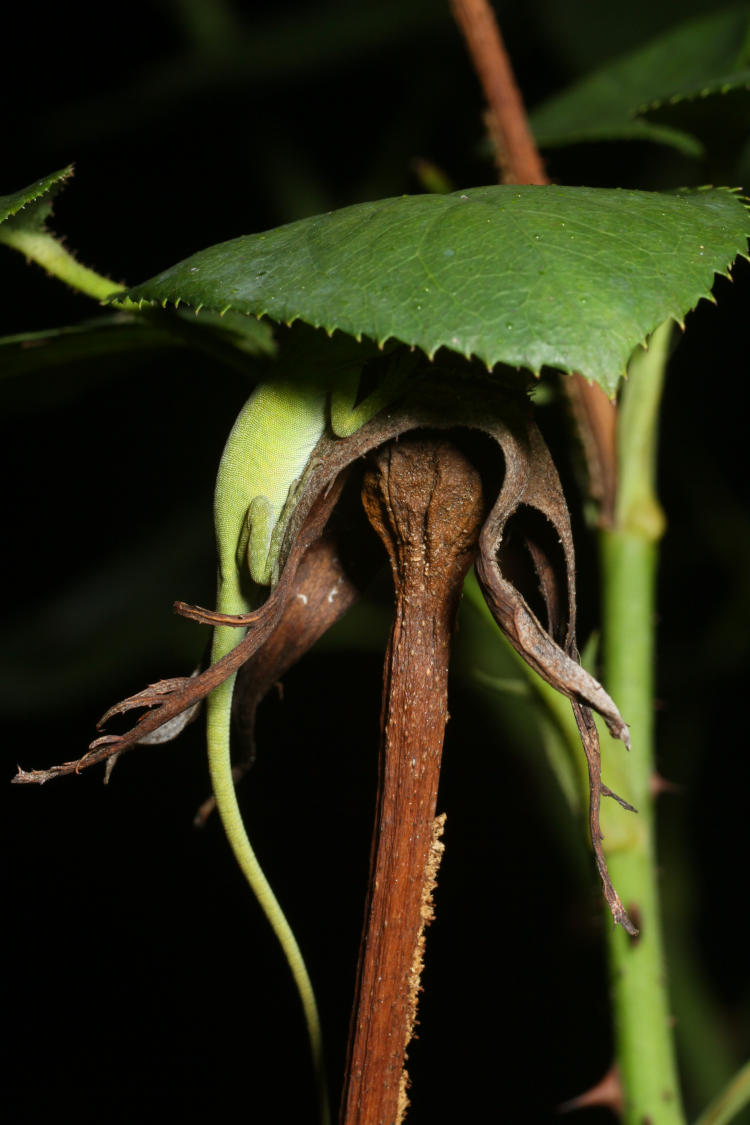The other day I did the rounds of Walkabout Estates to see what was happening among the nonhuman residents, kind of like a camp counselor but with a lot less chance of finding kids sneaking peeks at a bootleg copy of Emmanuelle vs Ghidra. What I did find, however, was a notable difference in the hue of the green treefrogs (Hyla cinerea) that were snoozing for the day, just within the boundaries of the Estate which, despite your impressions of nature photographer income, is humbly modest. It was worth illustrating, so we have more post fodder, with the first set of these photos taken within twenty minutes and twenty meters of one another. We’ll start with the bright one.

This is the only adult in the lineup, tucked in to the main trunk/stalk of one of the trumpet flowers (Brugmansia.) The flash might have brought this one out a little brighter than subjective observation of it within its shaded location, but it’s safe to say this was a pretty brilliant green in color.
Now we go to the front door.

This is a juvenile, so about half the size of the previous, and probably the most ‘average’ of the color variants that I see – bright green, but within the realm of brighter/paler leaves.
This one, by the way, returned a couple or mornings later and spent the entire day in this spot, riding the door back and forth as we passed through it well over a dozen times. I have no idea what it thought about this, but we tried to keep it low-key.
Now for one on the coiled up garden hose, another juvie.

The flash undoubtedly made this seem brighter than it appeared in the deep shade of its hiding spot, because it looked almost black when first spotted. This is as dark as I’ve found them, and not very frequently at that. Not blending in with the hose too well, but still subtle within the shadows.
And now the weird one.

The bronze color is something that I’ve seen before, but I’ve never seen any frog in such a clearly defined two-toned pattern, and I have no idea what caused this. I know frogs can change color, but I’ve never seen it happen and don’t get the impression that it’s a quick change, not to mention that the brownish color is hardly needed to blend in with the hydrangea leaf (but notice the color around the nostril.) I revisited this one throughout the day to see if the pattern changed at all, but saw no evidence of it. I have found no signs of this one since either, but if it completed a hue shift, I may simply not have recognized it.
I know what you’re thinking: Why didn’t you maintain constant surveillance, since it was so conveniently at hand? Do you call yourself a dedicated nature photographer or what? Which is pretty presumptuous, given how much I post here just to keep you in the loop, but sure, fine. I do have a life, of sorts, so standing there all day long wasn’t quite in the cards. But I will be continually watching for such things in the future.
Two days earlier, another had demonstrated no knowledge of camouflage whatsoever when it perched on a large leaf from the same oak-leaf hydrangea (Hydrangea quercifolia.)

There’s a chance this is actually the same as the one above, within the same general size, though I feel this was actually a tad smaller, but given the separation of days versus the trivial separation of perch distance (like half a meter,) the odds favor them being the same. We’ve seen this leaf earlier, but the weight of the frog detached it from the main stem and it soon wilted. Still, there were plenty of choices that weren’t quite so obvious.
But while we’re here, we’ll check in on the anoles, or at least, one in particular.

The juvenile Carolina anole (Anolis carolinensis) that was found, multiple times, hanging around the front garden is still there, and still found routinely, photographed occasionally. The other night it had taken shelter in at the top of an old rose blossom under a leaf – perhaps a good hiding place if you don’t value your tail. Still, the head was difficult to make out even if you were specifically trying, but at an angle where the morning sun would alert it that day had broken, so perhaps not as thoughtless as initially imagined.

No real surprise since I always find it at night with the powerful beam of the headlamp, but the anole is always aware that I’m around, even if disinclined to move, so yes, you can barely see the open eye here.
The next night it was in a slightly different location, without any shelter at all but with, perhaps, a little residual heat from the day.

This is another of The Girlfriend’s mobile yard sculptures, like the ones that the frogs seem to like, and has appeared here before too. I’ll note that the anole tends to be pale at night, but will soon darken in the morning to blend in with whatever it’s on and/or absorb more morning sunlight – you’d think it could do this at night for camouflage, but any common predators probably aren’t active at night anyway and the color change might be a conscious effort. Either way, I usually have a much harder time spotting this one during the day, unless it moves (which is how I find a large percentage of my photo subjects anyway.) I’m delighted to have the resident, and torn between getting cool photos and letting it go undisturbed, but there’s always the chance that my repeated presence is conditioning it to not worry about me and it’ll become more tolerant. I can justify anything if I try…



















































